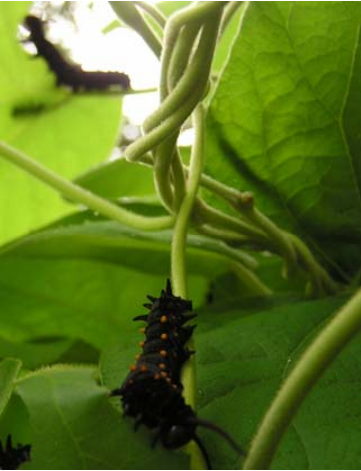Garden Caterpillar Crowd
Garden Caterpillar Crowd was originally published in the BFEC Newsletter, Vol. 15/No. 3, Summer 2011.
 If you've read many BFEC publications, you've probably heard us mention the importance of native plants. Our Wildlife Garden is stacking with them because many butterflies require specific native plant species on which to lay their eggs. This is a great time of year to look on our milkweed plants for monarch caterpillars or Queen Anne's lace for tiger swallowtail caterpillars.
If you've read many BFEC publications, you've probably heard us mention the importance of native plants. Our Wildlife Garden is stacking with them because many butterflies require specific native plant species on which to lay their eggs. This is a great time of year to look on our milkweed plants for monarch caterpillars or Queen Anne's lace for tiger swallowtail caterpillars.
But the most obvious caterpillar crowd in the garden is on our Dutchman's pipe plant, which can be found vining up a trellis in the garden near the cob shed. In early August it often harbors dozens of pipevine swallowtail caterpillars. The caterpillars are black, with small black spikes topped with orange spots. While they usually reside on the underside of leaves, they give away their presence by leaving conspicuously defoliated patches. Plant chemicals make the caterpillars and adult butterflies poisonous, and predators learn to avoid them. Several other swallowtail butterflies mimic the pipevine swallowtail (which is black with iridescent blue wings) hoping for free predator protection.